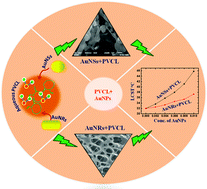Gold nanospheres/nanorods as highly promising candidates for the hydrophilic/hydrophobic balance of poly(N-vinylcaprolactam): a thoughtful design of nanocomposites†
Abstract
The thermally induced solubility alteration of the widely accepted thermoresponsive polymer poly(N-vinylcaprolactam) (PVCL) tethered to the surface of gold nanoparticles (AuNPs) is characterized by different biophysical techniques such as steady state fluorescence, thermal fluorescence, Fourier transform infrared spectroscopy (FTIR), dynamic light scattering (DLS) and zeta potential measurement. The surface morphology of nanocomposites formed by PVCL and gold nanospheres (AuNSs) and gold nanorods (AuNRs) was observed by scanning electron microscopy (SEM). The nanocomposites based on AuNPs and PVCL were examined by transmission electron microscopy (TEM). We report herein an increased lower critical solution temperature (LCST) of PVCL solution in the hydrophilic environment provided by AuNSs and AuNRs which indicated the application of these nanocomposites in biomedical applications. Interestingly, the phase transition temperature of aqueous PVCL was found to be tunable in the range of 32–45.8 °C in the microenvironment provided by AuNSs and AuNRs. AuNSs offer better binding affinity with PVCL, thereby increasing the LCST of aqueous PVCL up to 45.8 °C at their highest concentration (0.010 nM). On the other hand, AuNRs provide a less hydrophilic environment and approach the transition temperature of aqueous PVCL near the human body temperature (37.3 °C) at a concentration of 0.010 nM. It is especially helpful to monitor the LCST of PVCL by incorporating AuNSs and AuNRs as the thermoresponsive behavior imparted by the nanocomposites may find applications in responsive nanoreactors and potential medical devices. Therefore, this study reports how the different architectures of AuNPs affect the thermoresponsive behavior of PVCL. Moreover, this study can hold great promise in the controlled delivery of the guest drug molecules and pave the way to advance the thermoresponsive behavior of PVCL by nanocomposite formation with advanced nanomaterials like AuNSs and AuNRs.



 Please wait while we load your content...
Please wait while we load your content...